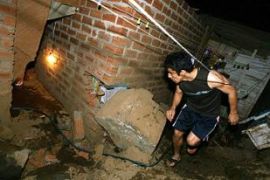‘Straight lines mean faster quakes’
Study says earthquakes can move faster than 2.5 km to 3 km per second.

Published On 16 Aug 2007
Earthquakes generally move, or “rupture”, at a pace of about 2.5 km to 3 km per second, and for a long time researchers believed quakes could not exceed these speeds.
But the study bolsters theories that they can, said Das.
Using more powerful computers, higher quality seismograms and new imaging techniques, researchers showed that a 7.8 magnitude earthquake in 2001 in Central Tibet that ruptured along the Kunlun fault line, moved at about 5 km per second.
The study found that long, straight fault lines create the opportunity for earthquakes to build up speed. Das compared the effect to driving a car on a straight road.
“If the road bends you have to slow down, or if you have a bump you have to slow down,” she said in a telephone interview. “Earthquakes behave in a similar way.”
San Andreas fault
After showing that quakes could move much faster than previously thought, Das turned her attention to California’s San Andreas fault and found that many parts of it run in the kind of long, straight lines that make it prone to these quick quakes.
The fault , which triggered the 1906 San Francisco quake and deadly fires that followed, runs from the Southern California desert to northern California and marks the boundary of the Pacific and North American tectonic plates.
“We know there are going to be more earthquakes on the San Andreas Fault,” she said.
“If the next one behaves this way, there would be a greater potential for damage than previously believed.”
These highly destructive quakes which can generate powerful shock waves, similar to the sonic boom from a supersonic aircraft .
She said they were most likely to hit in so-called strike-slip quakes, in which two sides of the fault slide past one another horizontally.
She noted that thrust-fault earthquakes, where plates go underneath each other – like the one that struck Peru on Wednesday, killing hundreds of people – would probably not produce such shock waves.
But the next step would be to identify faults around the world that could cause these more powerful quakes, Das said.
Source: News Agencies